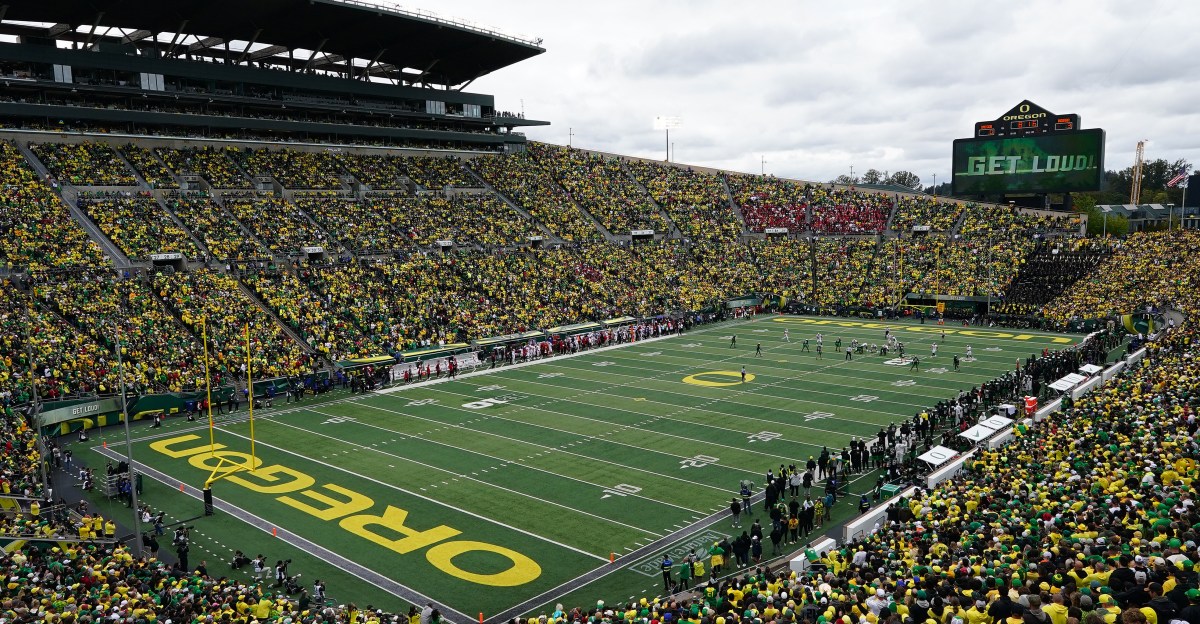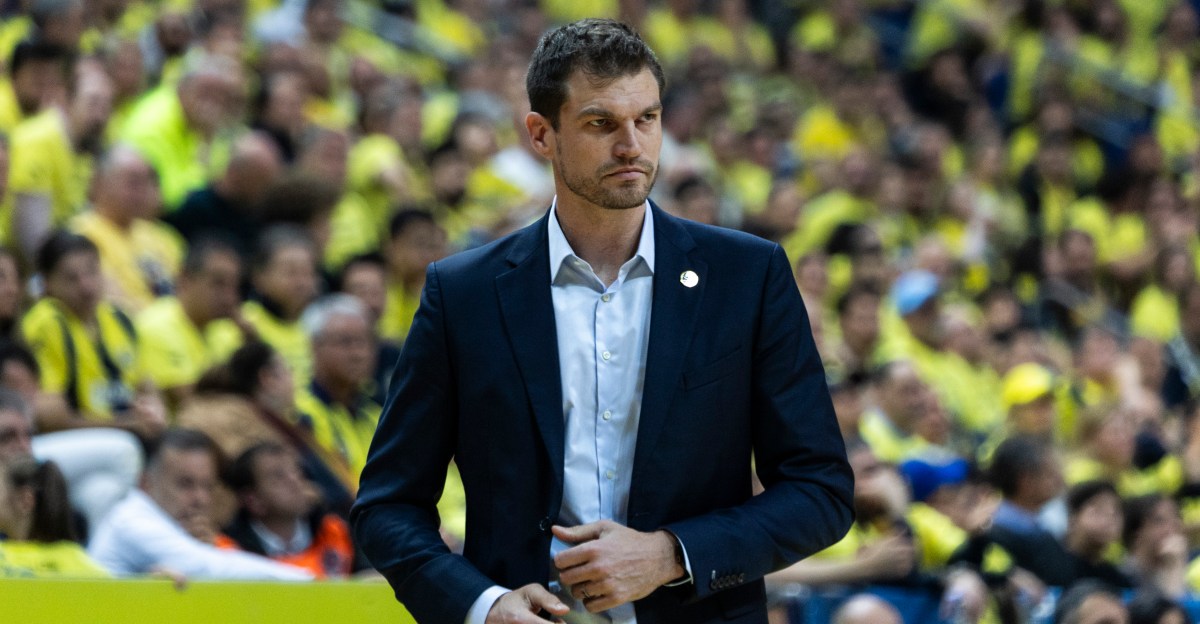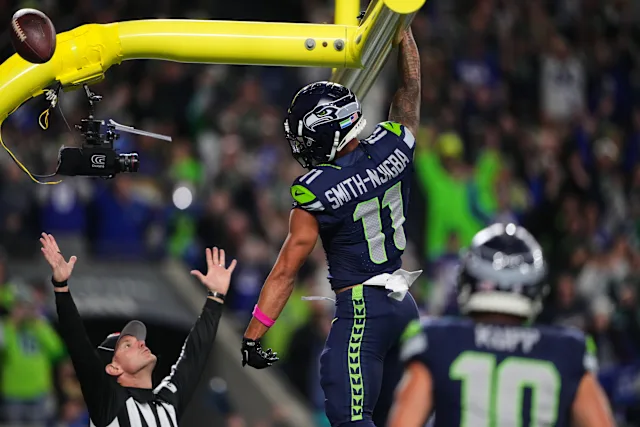Big Ten Football: Oregon Ducks 2024 Defensive Developmental Player Film Review
The best athletic programs, in any sport, don’t manage their rosters one year at a time. While the transfer portal is an important tool in roster management in modern college football, most contributing starters spend time on the team developing as young players.
In this article, I present my findings from reviewing the garbage time footage of Oregon’s defense this season that features developmental players. These players are usually in their first two years in the program and do not see regular playing time until the outcome of the game has already been decided. Previously, I’d examined the offensive players’ tape.
Readers should note that the sample of plays for each of these players is relatively small. Further, the time developmental players are on the field the outcome of the game is decided and play calling has been adjusted by both teams to reflect this.
As such, though I graded each player’s performance on every play I charted, I do not have the kind of information I would need to make a prediction about how these players would perform as starters. Rather, this footage is useful to gauge a player’s potential should they develop fully, as well as to inform off season roster management decisions made by the coaching staff.
Because ATQ does not have access to coaches’ all-22 film and relies on broadcast angles, secondary play is the hardest for us to grade. I made a special effort to include as many grades and clips of the developmental secondary as possible though the Ducks will be replacing all five starters from 2024. At the outside corner and nickel back positions Oregon had three developmental players who rotated in when the starters left the field. RS-Jr. (as of 2025) #13 Sione Laulea transferred from the JC ranks and played in only four games last season to preserve a redshirt. I also saw RS-So. #16 Rodrick Pleasant and RS-Fr. #27 Daylen Austin during garbage time. Austin showed up on my tally sheet more than Pleasant and Laulea combined, but he also had the worst grades of the three. Again, with garbage time film I wouldn’t take these results as definitive, but he certainly has work to do on his fundamentals and body control.
Below is an illustrative collection of clips featuring successful defense from the corners. As a reminder, you can use the “Settings” gear in the bottom right of the player to adjust the playback speed.
- (0:00) – Austin, wearing #27, is lined up in the slot (as he was most often) over the tight end to the offense’s right. When he sees his man isn’t running a route but setting up to block for a possible check down to the RB he attacks the TE’s block and gains leverage to defend the sideline. The QB is under pressure and late with the throw allowing the linebacker #4 Jacobs to take away his path upfield. Austin gets off the block in time to assist with a TFL.
- (0:24) – This clip, more than any other, shows the difference between players like the experienced former 3-stars Oregon had starting in the back end of the defense last year and the kind of athletes they have been recruiting out of high school the past few cycles. Laulea is #13 in press coverage at the top of the screen. He’s beaten to the inside off the snap and the safety moves with the tight end running toward the flat so the QB thinks he’s got a score on the post route. You cannot coach length though, and Laulea stays close enough to be able to get a hand on the ball and prevents a touchdown.
- (0:47) – Laulea is back in press coverage, to the bottom of the screen this time. He plays the receiver very physically on fourth and short, and in fact a flag for DPI was thrown. It was picked up however because his long arms actually deflected the ball before it crossed the line of scrimmage, so this didn’t count as a downfield throw.
- (0:54) – Pleasant, #16, is in man coverage with no help on the receiver lined up into the boundary on the offense’s left. He misses his jam off the snap, but is able to stay in phase to force an accurate throw. This being a backup QB in the Big Ten, such accuracy is not forthcoming. Notice that while he has a hand on the receivers’ chest, he doesn’t grab or restrict, resulting in the receiver’s half-hearted search for a flag.
As seen on the clips above, the film shows each of these players have upside at the D1 FBS level. They also have work to do to improve in the off season to see meaningful playing time. Below are some examples of errors from the developmental corners.
- (0:00) – Blitzing is an unusual assignment for a corner, but this clip illustrates a frustrating trend I found in Austin’s film: missed tackles. Notice how the receiver signals the incoming rush to the QB before the snap. Austin is running full tilt for the spot he expects the QB to drop to rather than coming in under control to react if he scrambles. The result is the QB runs right by the free rusher. Fortunately LBs #29 Porter and #54 Mixon do a nice job limiting the gain.
- (0:08) – Try to ignore the linebacker #4 who lets the QB loose on this outside zone read, keep your eyes on #16 Pleasant on the outside receiver at the top of the screen. He gets driven back at first, but recovers to get off the block. However he then completely whiffs on the tackle and the QB gets about another 10 yards downfield before he is caught.
- (0:19) – The safety blitz from #24 Lopa causes the quarterback to throw a checkdown to avoid a sack. The pass defenders are struggling in man coverage as the routes develop. The playside ILB, #23 Platt, gets crossed up by the tight end. Worse is #27 Austin pursuing the motion man to the flat and running right into the back on the wheel route. Had the ball been thrown beyond the LoS Austin would be called for DPI, as it is #11 Kam Alexander has to come off his man to make a tackle past the first down marker.
- (0:29) – Laulea is lined up in press coverage to offense’s left at the bottom of your screen. He never tries to jam his man though and seems to stumble slightly in his backpedal. This gives the receiver a free inside release for an easy catch and first down.
Oregon also used three developmental players at the safety positions, 2025 true Sophomore #12 Peyton Woodyard, RS-So. #19 Tyler Turner, and RS-Fr. #24 Kingston Lopa. Lopa saw a handful of snaps in the post-season during competitive play as part of a dime package, while Woodyard and Turner saw only garbage time duty. Lopa didn’t show up on my tally sheet as often but I would not be surprised if he became the official dime back next season. Woodyard and Turner will have a chance to earn playing time in the spring and fall. On my tally sheet Turner performed slightly better against both the run and the pass, but once again with garbage time these grades needed to be taken with a grain of salt.
Here is an illustrative sample of successful plays by the developmental safeties.
- (0:00) – Turner starts deep but spins down to take the TE who goes in motion to the offense’s right. When that same TE stays in pass protection Turner “green dogs” and goes for the QB, hurrying the throw and preventing proper follow through by the passer. Predictably, the ball sails, though notice #27 Austin was in pretty good coverage anyway.
- (0:10) – Lopa starts deep to the offense’s left but creeps up into the box anticipating a run. He engages the TE and keeps his helmet on his blocker’s inside shoulder to force the QB into the boundary. Kam Alexander, #11, does a nice job to get off his receiver’s block and hold the play to an even shorter gain.
- (0:19) – One of a safety’s primary jobs when playing deep is to serve as ‘plan b’ in case the d-line and/or linebackers cannot make the play. Woodyard does just that from his boundary safety position. Backup linebacker #22 Soelle has a chance to stop this little swing pass for a short gain but misses the tackle. Woodyard reacts quickly and is able to hold the RB short of the line to gain, giving the defense a chance to get off the field on 4th and short.
- (0:28) – This screen pass is a big success on 2nd and long, but that is mostly because the linebackers get stuck on a block and miss a tackle. Turner, #19, takes a bad angle here but Woodyard, #12, stays with the play along with CB #16 Pleasant prevents a first down.
As with nearly all underclassmen, all three safeties still need to make progress recognizing the play and reacting appropriately. A bit more time in the weight room (particularly for Lopa with his huge 6’ 5” frame) will be beneficial as well. Here are a few examples of failed plays by the safeties.
- (0:00) – Turner is over the TE to the boundary on this toss play. He correctly pursues the motion man to protect the sideline but he needs to keep his head up and stay on his feet to force the runner back to his help. When he dives at the blocker’s legs he takes himself out of the play and gets run by. Worse, this counts as an illegal chop block on the defense and Michigan State gets a free first down.
- (0:14) – Woodyard, #12, is covering the tight end to the boundary toward the top of the screen. He has forgotten what the coaches were emphasizing all week in film study: the Spartans love to run play action bootlegs from under center so coverage needs to stick with the eligible receivers. Once Woodyard moves forward into the run gap it’s all over. If the ball wasn’t underthrown this might have been a touchdown. If Woodyard played the pass and #27 Austin had rushed the QB when he saw both TEs to the field stay in pass protection the defense could have gotten a sack or a throwaway.
- (0:32) – Though I put this in the safeties compilation, everyone in the secondary except #13 Laulea and #21 RS-Fr. Aaron Flowers (who only saw action in this one game and didn’t get recorded on my tally sheet) gets a frowny face. The in route from the lone receiver to the field is open because #11 Alexander loses inside leverage on a failed jam. That doesn’t matter though since #27 Austin gives up inside leverage on the deep post off the line of scrimmage. Woodyard is playing center field and by watching the QB instead of the routes developing he ends up standing around surrounded by empty turf.
- (0:58) – Turner is in position to contest this in-breaking route to the Beavers’ #7, and he reacts well. The path he takes isn’t quite direct enough though and there is just enough time for the receiver to secure the catch. It still goes down as an error, but even experienced defenders give up a play like this occasionally.
After last year’s developmental player review, I had suspected we would see edge #17 Blake Purchase as a pass rush specialist in 2024. The staff instead decided to utilize a redshirt year for him, so he enters 2025 as a RS-So. Fellow edge’s RS-So. #29 Ashton Porter and RS-Fr. #47 Elijah Rushing. Purchase and Porter graded out pretty similarly in the limited sample I had from them. Since they have now both redshirted I would not be surprised if they rotated in on the outside of the defensive line in non-garbage time this coming season.
Below is a sample of successful plays from the developmental edge defenders.
- (0:00) – Purchase is in a two point stance to the offense’s right. He springs forward at the snap and converts speed to power, driving the right tackle back in the QB’s lap. Knowing he’s running out of time the quarterback checks down for a short gain. Without pressure, the QB might have seen MSU #11 coming open over the middle.
- (0:12) – Notice Purchase, lined up on the offense’s left this time, signaling this will be a pass. He takes an outside path against the block, aiming for the top of the anticipated roll out. He keeps his balance and forces another quick checkdown before the routes can develop downfield.
- (0:21) – Rushing, over the left tackle, gets in the quarterbacks face first. Thanks to Porter coming around the offense’s right and interior pressure from #50 Gray there is nowhere to escape so the QB just forces a throw to his first read who is blanketed by the coverage. He’s not a developmental player, but this interception by #11 Kam Alexander was too cool to leave out.
- (0:41) – There is a possible issue running a stunt with #29 Porter and #99 Green to the offense’s left. The Huskies are running outside zone this way so the offensive line might be able to use their momentum against them to make a hole. Porter doesn’t let that happen though, engaging both the center and the left guard. By the time the guard releases Green has position to control him and get into the C-gap for the tackle. There was nowhere the for the RB to cut back to because Porter had worked free and was pursuing down the line.
All three edge defenders flashed their athleticism on film, Purchase in particular. As one would suspect of young players they all have plenty of refinement they can still make to their game. Here are some examples of failed plays from the edge defenders.
- (0:00) – Lined up in a two point stance to the offense’s left, Porter’s job is to attack the outside shoulder of the TE slicing across the formation to set the edge. He makes contact on the blocker’s inside shoulder instead, opening a cutback lane for the runner around the left side. The safety #19 Turner and ILB #54 Mixon do well to cut him off, but over pursuit by both turns this from a 4 yard run to 7 yards and sets up second and short.
- (0:10) – Purchase has his hands in the dirt to the offense’s right on third and long. The defense is selling out against the pass, trusting even a successful run won’t get 12 yards. Purchase is far too quick for the up–back, but he’s so focused on the QB he doesn’t play the mesh and the running back goes right by him. He shows impressive hustle to turn and run the play down from behind though.
- (0:19) – Keep your eyes on #47 Rushing to the offense’s right. He shows great use of his hands off the snap to control his blocker. While the tackle resorts to some Big Ten style blocking with his left hand, pay close attention to the offensive linemen’s right hand. When he swipes at Rushing’s own right hand, Rushing loses his balance and gets pinned to the turf. The loss of contain allows the quarterback to escape to his left. The linebacker, #54 Mixon, is put in conflict but the lesser of two evils is to stick with the tight end in coverage and not play the scramble until the QB had committed to run.
- (0:32) – Porter has backside contain on the offense’s left against a QB keep on this outside zone read. He makes the same mistake this quarterback will be forcing for years to come and moves too far down the line of scrimmage. Without a proper angle he ends up on the Autzen turf.
Oregon had three players young enough to still be in development rotate in at defensive tackle during garbage time: RS-Fr. #42 Aydin Breland, RS-FR. #50 Tionne Gray, and RS-So. #99 Terrance Green. On my tally sheet Breland only barely shows up, while Green grades out very well against the run and Gray shows more disruptiveness against the pass. Simply based on seniority Green would seem the most likely to see meaningful playing time next season, though Gray could carve out a role in pass rush situations.
Behind the DTs in the middle of the defense I only have two developmental players at inside linebacker on my tally sheet in RS-Fr. #23 Brayden Platt and Junior #54 Jerry Mixon. Platt was a true freshman in 2024 who saw a grand total of six snaps (one on special teams) and the only time he showed up on my tally sheet once was shown in (CB-G clip …). Given the depth at ILB I’d be it would be a surprise if Mixon wasn’t part of the regular rotation in the fall.
Here is an illustrative sample of successful plays by interior defenders, both DT and ILB.
- (0:00) – There are no free rushers on this third and long, but the entire defensive front is compressing the pocket. Breland puts the center on skates and #47 Rushing compresses the pocket from the QB’s left, forcing him to take off and get what he can. It isn’t enough.
- (0:07) – Both DT’s put on teaching tape of how to play against outside zone on this play. Gray and Green both work to get their helmet’s playside and force the runner to cut back. There is no hole for the back to work with, he is forced to get low and burrow forward for a yard.
- (0:16) – The quarterback tries to step up in the face of pressure and thinks about running, but Green works back across a double team to cut him off and Mixon is coming down from zone coverage as well. Without a lane to work with, the QB releases an awkward check down that gives #27 Austin the opportunity for a TFL.
- (0:26) – We didn’t get a replay with a better angle this late in the game, but watch #99 Green at nose tackle. He realizes this will be a quick throw and gets a hand up, leading to a deflection. It might have been the best case scenario for the offense as #54 Mixon is waiting on the slant to either try for a pick or de-cleat the receiver.
Both Green and Mixon look fully grown into their athletic bodies, but even they lack significant live game experience at the college level. Here are some examples of failed plays by the interior defenders.
- (0:00) – The defensive line is slanting to the offense’s right, which is where the play was supposed to go. The problem is when Mixon engages the TE on the offense’s left his helmet is to the outside, creating a gap between him and the slanting #29 Porter. He needed to engage the blocker’s inside shoulder to spill the run to #27 Austin.
- (0:07) – This is a very mixed bag for the defensive front. They do a great job getting pressure, but the quarterback looks like a greased pig at the Pendleton Rodeo. Purchase has the first chance coming free off the offense’s left. After he gets up Breland gets a shot but can’t wrap up. Porter has broken through at this point and finally wraps up the QB, and Purchase can at least say he helped. You can tell from Breland’s reaction he knows he missed an opportunity.
- (0:32) – An interior twist by Green and Gray works against them here as they wind up with their heads in the wrong gaps. Some good hustle from Mixon and a nice reaction from #24 Lopa at the safety spots prevents a disaster.
- (0:39) – There are several technique errors by the line on this play. Gray slants into the offense’s left side A-gap but lunges out of his stance and is easily washed down. Green, next to him, gets too high and cannot hold his ground. On the offense’s right at defensive end #47 Rushing turns his shoulders to the line of scrimmage and gets escorted downfield.
Share this content:















Post Comment